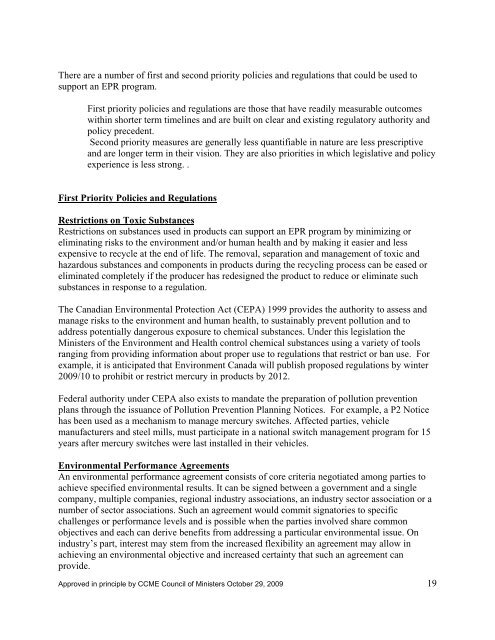Canada-Wide Action Plan for Extended Producer ... - CCME
Canada-Wide Action Plan for Extended Producer ... - CCME
Canada-Wide Action Plan for Extended Producer ... - CCME
You also want an ePaper? Increase the reach of your titles
YUMPU automatically turns print PDFs into web optimized ePapers that Google loves.
There are a number of first and second priority policies and regulations that could be used to<br />
support an EPR program.<br />
First priority policies and regulations are those that have readily measurable outcomes<br />
within shorter term timelines and are built on clear and existing regulatory authority and<br />
policy precedent.<br />
Second priority measures are generally less quantifiable in nature are less prescriptive<br />
and are longer term in their vision. They are also priorities in which legislative and policy<br />
experience is less strong. .<br />
First Priority Policies and Regulations<br />
Restrictions on Toxic Substances<br />
Restrictions on substances used in products can support an EPR program by minimizing or<br />
eliminating risks to the environment and/or human health and by making it easier and less<br />
expensive to recycle at the end of life. The removal, separation and management of toxic and<br />
hazardous substances and components in products during the recycling process can be eased or<br />
eliminated completely if the producer has redesigned the product to reduce or eliminate such<br />
substances in response to a regulation.<br />
The Canadian Environmental Protection Act (CEPA) 1999 provides the authority to assess and<br />
manage risks to the environment and human health, to sustainably prevent pollution and to<br />
address potentially dangerous exposure to chemical substances. Under this legislation the<br />
Ministers of the Environment and Health control chemical substances using a variety of tools<br />
ranging from providing in<strong>for</strong>mation about proper use to regulations that restrict or ban use. For<br />
example, it is anticipated that Environment <strong>Canada</strong> will publish proposed regulations by winter<br />
2009/10 to prohibit or restrict mercury in products by 2012.<br />
Federal authority under CEPA also exists to mandate the preparation of pollution prevention<br />
plans through the issuance of Pollution Prevention <strong>Plan</strong>ning Notices. For example, a P2 Notice<br />
has been used as a mechanism to manage mercury switches. Affected parties, vehicle<br />
manufacturers and steel mills, must participate in a national switch management program <strong>for</strong> 15<br />
years after mercury switches were last installed in their vehicles.<br />
Environmental Per<strong>for</strong>mance Agreements<br />
An environmental per<strong>for</strong>mance agreement consists of core criteria negotiated among parties to<br />
achieve specified environmental results. It can be signed between a government and a single<br />
company, multiple companies, regional industry associations, an industry sector association or a<br />
number of sector associations. Such an agreement would commit signatories to specific<br />
challenges or per<strong>for</strong>mance levels and is possible when the parties involved share common<br />
objectives and each can derive benefits from addressing a particular environmental issue. On<br />
industry’s part, interest may stem from the increased flexibility an agreement may allow in<br />
achieving an environmental objective and increased certainty that such an agreement can<br />
provide.<br />
Approved in principle by <strong>CCME</strong> Council of Ministers October 29, 2009 19
















